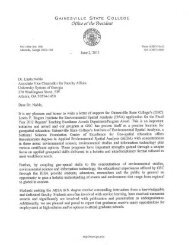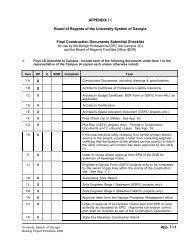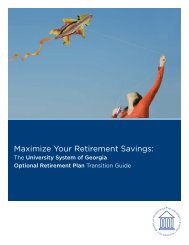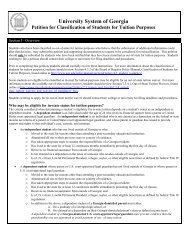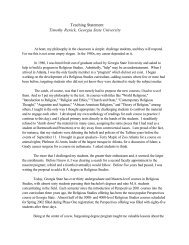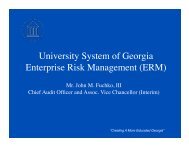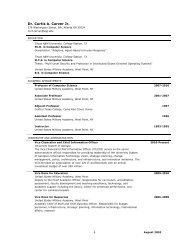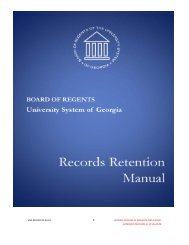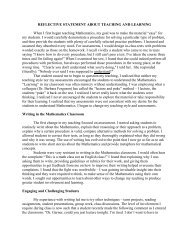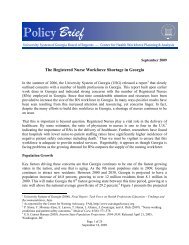66902 Federal Register / Vol. 75, No. 209 / Friday, October 29, 2010 / Rules and RegulationsWReier-Aviles on DSKGBLS3C1PROD with RULES2Discussion: We do not agree. Aninstitution must act in accordance with§ 668.164(g), which contains therequirements for making a latedisbursement, including circumstanceswhere a student did not have a validSAR or valid ISIR on the student’s lastdate <strong>of</strong> attendance.Changes: None.Verification and Updating <strong>of</strong> StudentAid Application Information (Subpart E<strong>of</strong> Part 668)General (§ 668.51)Comment: One commenter questionedwhether the <strong>Department</strong> woulddescribe, in the final regulations, ourplans to provide training to assistinstitutions to prepare for and complywith verification requirements reflectedin subpart E <strong>of</strong> part 668.Discussion: The <strong>Department</strong> will issueguidance through the Application andVerification Guide and other trainingmaterials, as needed. The <strong>Department</strong>will also provide training through ourregional training <strong>of</strong>ficers. Forinformation on our current and futuretraining activities and learningresources, institutions should visit theTraining for Financial Aid Pr<strong>of</strong>essionalsWeb site at http://www2.ed.gov/<strong>of</strong>fices/OSFAP/training/index.html.Changes: None.Comment: Some commentersrequested that the <strong>Department</strong> delayimplementing the new verificationrequirements until the 2012–13 awardyear to give institutions sufficient timeto train their staff and make thenecessary system changes.Discussion: The <strong>Department</strong>recognizes that institutions may needtime to make changes to theirinstitutional processing systems tocomply with the requirements insubpart E <strong>of</strong> part 668. Accordingly, asdescribed in the DATES section <strong>of</strong> thesefinal regulations, we will delay theeffective date <strong>of</strong> the changes to thissubpart until July 1, 2012, which meansthat it will be effective for the 2012–13award year.Changes: None.Comment: Some commenters notedthat because no new loans can becertified under the Federal Family<strong>Education</strong> Loan (FFEL) Programeffective July 1, 2010, all references tothe FFEL Program and loan certificationshould be removed from the regulatorylanguage in this subpart.Discussion: We concur with thecommenters. We had not removed thereferences to FFEL in the NPRM becausethat notice was already underdevelopment when the legislativechange to end new lending under theFFEL Program was enacted. Our intentwas to make the necessary technicalcorrections in the final regulations.Changes: Throughout subpart E <strong>of</strong>part 668, we have removed references tothe FFEL Program and anycorresponding regulatory citations.Specifically, we have removedreferences to ‘‘Subsidized StaffordLoan,’’ ‘‘Unsubsidized Stafford Loan,’’‘‘Federal PLUS Loan,’’ and ‘‘lender’’ aswell as certifications for SubsidizedStafford loans from §§ 668.52, 668.58,and 668.60.Definitions (§ 668.52)Comment: Some commentersexpressed support for the <strong>Department</strong>’sefforts to simplify and clarify thedefinitions used throughout theverification regulations under subpart E<strong>of</strong> part 668. One commenter noted thatchanging the defined term applicationto FAFSA, and using the term FAFSAinformation in place <strong>of</strong> the termapplication helps distinguish theFAFSA from other financial aidapplications used at many institutions.Discussion: We appreciate thecommenters’ support.Changes: None.Comment: Two commenters suggestedthat we change the names <strong>of</strong> the definedterms FAFSA information, subsidizedstudent financial assistance programs,and unsubsidized student financialassistance programs. Specifically, onecommenter suggested that we use theterm ‘‘Federal Methodology (FM) needanalysis data’’ or ‘‘ISIR data’’ rather thanFAFSA information to better reflectwhat institutions receive once the datareported on the FAFSA have beenprocessed. In addition, one commenterstated that using the terms ‘‘subsidized’’and ‘‘unsubsidized’’ to modify studentfinancial assistance programs willconfuse applicants because those termsare more commonly used when referringto loan programs. The commenter statedthat families would better understandthe type <strong>of</strong> aid we are referring to byusing the terms ‘‘need-based studentfinancial assistance programs’’ and‘‘non-need-based student financialassistance programs.’’Another commenter requested thatthe <strong>Department</strong> include in theregulations definitions for the terms‘‘applicant’’ and ‘‘timely manner.’’Discussion: While we appreciate thesuggestions, we do not believe thesuggested changes are necessary. Wealso do not agree that using the term‘‘subsidized’’ and ‘‘unsubsidized’’throughout subpart E will confuseapplicants and their families about thetype <strong>of</strong> aid we are referring to sincethese regulations are written for FAAs atVerDate Mar2010 14:10 Oct 28, 2010 Jkt 223001 PO 00000 Frm 00072 Fmt 4701 Sfmt 4700 E:\FR\FM\29OCR2.SGM 29OCR2institutions <strong>of</strong> higher education and notapplicants and their families. Aninstitution may, when communicatingwith students and families, usewhatever terminology it believes willbest be understood by its students andfamilies.However, we did make some revisionsto the list <strong>of</strong> definitions under § 668.52.Specifically, we determined that thedefinitions for Free Application forFederal Student Aid (FAFSA),Institutional Student InformationRecord (ISIR), and Student Aid Report(SAR) would be more appropriatelyincluded in § 668.2(b) <strong>of</strong> subpart Abecause these terms are used throughoutpart 668 <strong>of</strong> the Student AssistanceGeneral Provisions regulations and notjust under subpart E.We also revised the definitions forValid Student Aid Report (valid SAR)and Valid Institutional StudentInformation Record (valid ISIR) in§ 668.2(b) to specify that a valid ISIR isan ISIR on which all the informationreported on a student’s FAFSA isaccurate and complete as <strong>of</strong> the date theapplication is signed, and a valid SARis a student aid report on which all <strong>of</strong>the information reported on a student’sFAFSA is accurate and complete as <strong>of</strong>the date the application is signed.In addition, we also changed thedefined terms from Student Aid Report(SAR) to Valid Student Aid Report(valid SAR) and Institutional StudentInformation Record (ISIR) to ValidInstitutional Student InformationRecord (valid ISIR) under §§ 668.54(b),668.58, 668.59, and 668.61. Prior tothese final regulations, an institutionwas not required to obtain a valid SARor valid ISIR in order to make adisbursement under the campus-basedprograms and the title IV, HEA loanprograms. Institutions could rely ontheir own calculations to determine anapplicant’s award amount withouthaving to submit corrections throughthe <strong>Department</strong>’s Central ProcessingSystem (CPS) and receiving thecorrected SAR or ISIR. Consistent withthe revisions to § 668.59(a), whichrequire that any change to a nondollaritem and any change to a dollar item onthe FAFSA that is $25 or more must besubmitted to the CPS for reprocessing,an institution must have a valid SAR ora valid ISIR to disburse funds from thesubsidized student financial assistanceprograms. By definition, a valid SAR orvalid ISIR can only be created afterinformation has been processed throughthe <strong>Department</strong>’s Central ProcessingSystem.Finally, we also determined that weno longer need to define the terms validSAR or valid ISIR under 34 CFR 690.2
Federal Register / Vol. 75, No. 209 / Friday, October 29, 2010 / Rules and Regulations66903WReier-Aviles on DSKGBLS3C1PROD with RULES2<strong>of</strong> the Federal Pell Grant Programregulations as they are defined in part668 because they apply to all <strong>of</strong> the titleIV, HEA programs. For this reason, wehave removed these definitions fromthis section.Changes: The terms andcorresponding definitions for FreeApplication for Federal Student Aid(FAFSA), Institutional StudentInformation Record (ISIR), and StudentAid Report (SAR) have been removedfrom § 668.52. Instead, we now defineFree Application for Federal StudentAid (FAFSA), Institutional StudentInformation Record (ISIR), and StudentAid Report (SAR) under Generaldefinitions in § 668.2(b). We have alsorevised the definitions for validInstitutional Student InformationRecord (valid ISIR) and valid StudentAid Report (valid SAR) in § 668.2(b). Wehave removed the definitions for theterms valid Student Aid Report (validSAR) and valid Institutional StudentInformation Record (valid ISIR) from 34CFR 690.2(b) and revised the definition<strong>of</strong> these terms under § 668.2(b) to nolonger refer to the definitions in 34 CFR690.2(b) <strong>of</strong> the Federal Pell GrantProgram regulations.Comment: One commenter asked the<strong>Department</strong> to clarify the meaning <strong>of</strong> theterm ‘‘applicant’’ as used throughout theverification regulations. The commentersuggested that the regulations shoulduse the term ‘‘applicant’’ to refer to astudent who is accepted for admissionat an institution, rather than to a studentwho submits a FAFSA. The commenterargued that having ‘‘applicants’’ cover allstudents who submit a FAFSA would beadministratively burdensome forinstitutions because it would requirethem to verify CPS-selected transactionsfor students who do not enroll at theinstitution.Discussion: The term ‘‘applicant,’’ asused throughout the verificationregulations, refers to an individual whoapplies for assistance under the title IV,HEA program by completing andsubmitting a FAFSA.While the term ‘‘applicant,’’ as used insubpart E <strong>of</strong> part 668 covers individualswho may not enroll at the institution,we note that § 668.54 only requires aninstitution to verify the FAFSAinformation selected by the Secretaryunder § 668.56 and any FAFSAinformation the institution has reason tobelieve is inaccurate. Therefore, onlythose applicants who are enrolled at theinstitution and whose FAFSAinformation falls into one <strong>of</strong> thesecategories are subject to verification.Changes: None.Policies and Procedures—Pr<strong>of</strong>essionalJudgment (§ 668.53(c))Comment: Many commentersexpressed support for § 668.53(c), whichrequires an institution to completeverification prior to exercising thepr<strong>of</strong>essional judgment authority allowedunder section 479A <strong>of</strong> the HEA. Thesecommenters indicated that thisrequirement, which is consistent withtheir policy to complete verificationfirst, is important to ensure that the datareported on the FAFSA is accuratebefore making any adjustments to it.Discussion: We appreciate thecommenters’ support.Changes: None.Comment: Some commentersquestioned the process for completingverification prior to exercisingpr<strong>of</strong>essional judgment in specialcircumstances that require adependency override in order to createa valid Student Aid Report (valid SAR)or valid Institutional StudentInformation Record (valid ISIR).Discussion: The authority given toFAAs to exercise pr<strong>of</strong>essional judgmentunder section 479A <strong>of</strong> the HEA isseparate and apart from the authoritygiven FAAs to make a dependencyoverride decision under section480(d)(1)(I) <strong>of</strong> the HEA. Section 479A <strong>of</strong>the HEA authorizes an FAA to makeadjustments on a case-by-case basis tothe cost <strong>of</strong> attendance or to the values<strong>of</strong> the data items used to calculate theEFC to allow for treatment <strong>of</strong> anindividual eligible applicant withspecial circumstances as long as theadjustments are based on adequatedocumentation.In the definition <strong>of</strong> ‘‘independentstudent’’ in section 480(d)(1)(I) <strong>of</strong> theHEA, an applicant may be considered tobe an independent student if the FAAmakes a documented determination thatthe applicant is independent by reason<strong>of</strong> other unusual circumstances.In practice, an FAA would firstdetermine whether an otherwisedependent applicant should beconsidered an independent studentusing the FAA’s authority under section480(d)(1) <strong>of</strong> the HEA, in order to obtaina valid SAR or valid ISIR, and thenwould subsequently make anycorrections or pr<strong>of</strong>essional judgmentadjustments to the applicant’s FAFSAinformation.We will provide guidance in theFederal Student Aid Handbook toaddress operational details as needed.Changes: None.Comment: Several commentersexpressed concern that requiring aninstitution to complete verificationbefore exercising pr<strong>of</strong>essional judgmentVerDate Mar2010 14:10 Oct 28, 2010 Jkt 223001 PO 00000 Frm 00073 Fmt 4701 Sfmt 4700 E:\FR\FM\29OCR2.SGM 29OCR2would make it difficult for institutionsto appropriately handle emergencysituations. The commenters noted thatdelays would occur as a result <strong>of</strong> havingto complete verification, submit anychanges to CPS, and wait for the newSAR or ISIR upon which thepr<strong>of</strong>essional judgment decision wouldbe based. Some commenters suggestedmaking modifications to systemss<strong>of</strong>tware, i.e. FAA Access, to allowmultiple changes to be madesimultaneously to resolve this problem.Discussion: We appreciate thecommenters’ suggestion for improvingour operational process. We will takethis suggestion into consideration as welook for ways to improve our services toinstitutions.Currently, the CPS will processchanges to an applicant’s FAFSAinformation as a result <strong>of</strong> theverification process or a pr<strong>of</strong>essionaljudgment determination and report theresults on a new ISIR sent to theinstitution usually the next day.However the two transactions cannot beprocessed on the same day. This isbecause after the institution receives theISIR that was created as a result <strong>of</strong>verification, the institution would usethat ISIR transaction to makeadjustments to the applicant’s FAFSAinformation using the pr<strong>of</strong>essionaljudgment process. While we understandthe commenters’ concerns about anydelay that may occur with having tosubmit transactions separately, webelieve that any delay will be slight. Inaddition, institutions have the option <strong>of</strong>making interim disbursements, asallowed under § 668.58, until acorrected valid SAR or valid ISIR isreceived.Changes: None.Comment: One commenter askedwhether an applicant who is selected toverify the parent’s household size, butwho requests that the institution use itspr<strong>of</strong>essional judgment authority undersection 479A <strong>of</strong> the HEA to examine theparent’s income listed on the FAFSA,would be required to verify all fiveitems before the institution couldexercise its pr<strong>of</strong>essional judgment.Another commenter argued that therequirement to complete verificationbefore exercising pr<strong>of</strong>essional judgmentwould delay the financial aid processand would create an additional hurdlefor families in need. This commenterquestioned why institutions have to gothrough an extra step to evaluate anapplicant’s eligibility through theverification process if the institution isupdating those same fields whenexercising pr<strong>of</strong>essional judgment torevise an applicant’s eligibility undersection 479A <strong>of</strong> the HEA.
- Page 1 and 2:
Friday,October 29, 2010Part IIDepar
- Page 3 and 4:
Federal Register / Vol. 75, No. 209
- Page 6 and 7:
66836 Federal Register / Vol. 75, N
- Page 8 and 9:
66838 Federal Register / Vol. 75, N
- Page 10 and 11:
WReier-Aviles on DSKGBLS3C1PROD wit
- Page 12 and 13:
66842 Federal Register / Vol. 75, N
- Page 14 and 15:
66844 Federal Register / Vol. 75, N
- Page 16 and 17:
WReier-Aviles on DSKGBLS3C1PROD wit
- Page 18 and 19:
66848 Federal Register / Vol. 75, N
- Page 20 and 21:
66850 Federal Register / Vol. 75, N
- Page 22 and 23: WReier-Aviles on DSKGBLS3C1PROD wit
- Page 24 and 25: 66854 Federal Register / Vol. 75, N
- Page 26 and 27: WReier-Aviles on DSKGBLS3C1PROD wit
- Page 28 and 29: 66858 Federal Register / Vol. 75, N
- Page 30 and 31: 66860 Federal Register / Vol. 75, N
- Page 32 and 33: 66862 Federal Register / Vol. 75, N
- Page 34 and 35: 66864 Federal Register / Vol. 75, N
- Page 36 and 37: 66866 Federal Register / Vol. 75, N
- Page 38 and 39: WReier-Aviles on DSKGBLS3C1PROD wit
- Page 40 and 41: WReier-Aviles on DSKGBLS3C1PROD wit
- Page 42 and 43: 66872 Federal Register / Vol. 75, N
- Page 44 and 45: WReier-Aviles on DSKGBLS3C1PROD wit
- Page 46 and 47: WReier-Aviles on DSKGBLS3C1PROD wit
- Page 48 and 49: WReier-Aviles on DSKGBLS3C1PROD wit
- Page 50 and 51: 66880 Federal Register / Vol. 75, N
- Page 52 and 53: WReier-Aviles on DSKGBLS3C1PROD wit
- Page 54 and 55: 66884 Federal Register / Vol. 75, N
- Page 56 and 57: 66886 Federal Register / Vol. 75, N
- Page 58 and 59: WReier-Aviles on DSKGBLS3C1PROD wit
- Page 60 and 61: WReier-Aviles on DSKGBLS3C1PROD wit
- Page 62 and 63: WReier-Aviles on DSKGBLS3C1PROD wit
- Page 64 and 65: WReier-Aviles on DSKGBLS3C1PROD wit
- Page 66 and 67: WReier-Aviles on DSKGBLS3C1PROD wit
- Page 68 and 69: WReier-Aviles on DSKGBLS3C1PROD wit
- Page 70 and 71: WReier-Aviles on DSKGBLS3C1PROD wit
- Page 74 and 75: WReier-Aviles on DSKGBLS3C1PROD wit
- Page 76 and 77: WReier-Aviles on DSKGBLS3C1PROD wit
- Page 78 and 79: 66908 Federal Register / Vol. 75, N
- Page 80 and 81: WReier-Aviles on DSKGBLS3C1PROD wit
- Page 82 and 83: 66912 Federal Register / Vol. 75, N
- Page 84 and 85: WReier-Aviles on DSKGBLS3C1PROD wit
- Page 86 and 87: 66916 Federal Register / Vol. 75, N
- Page 88 and 89: WReier-Aviles on DSKGBLS3C1PROD wit
- Page 90 and 91: WReier-Aviles on DSKGBLS3C1PROD wit
- Page 92 and 93: WReier-Aviles on DSKGBLS3C1PROD wit
- Page 94 and 95: 66924 Federal Register / Vol. 75, N
- Page 96 and 97: WReier-Aviles on DSKGBLS3C1PROD wit
- Page 98 and 99: 66928 Federal Register / Vol. 75, N
- Page 100 and 101: WReier-Aviles on DSKGBLS3C1PROD wit
- Page 102 and 103: 66932 Federal Register / Vol. 75, N
- Page 104 and 105: WReier-Aviles on DSKGBLS3C1PROD wit
- Page 106 and 107: 66936 Federal Register / Vol. 75, N
- Page 108 and 109: 66938 Federal Register / Vol. 75, N
- Page 110 and 111: 66940 Federal Register / Vol. 75, N
- Page 112 and 113: 66942 Federal Register / Vol. 75, N
- Page 114 and 115: 66944 Federal Register / Vol. 75, N
- Page 116 and 117: 66946 Federal Register / Vol. 75, N
- Page 118 and 119: WReier-Aviles on DSKGBLS3C1PROD wit
- Page 120 and 121: WReier-Aviles on DSKGBLS3C1PROD wit
- Page 122 and 123:
WReier-Aviles on DSKGBLS3C1PROD wit
- Page 124 and 125:
66954 Federal Register / Vol. 75, N
- Page 126 and 127:
WReier-Aviles on DSKGBLS3C1PROD wit
- Page 128 and 129:
66958 Federal Register / Vol. 75, N
- Page 130 and 131:
66960 Federal Register / Vol. 75, N
- Page 132 and 133:
WReier-Aviles on DSKGBLS3C1PROD wit
- Page 134 and 135:
WReier-Aviles on DSKGBLS3C1PROD wit
- Page 136 and 137:
WReier-Aviles on DSKGBLS3C1PROD wit
- Page 138 and 139:
66968 Federal Register / Vol. 75, N
- Page 140 and 141:
66970 Federal Register / Vol. 75, N
- Page 142 and 143:
66972 Federal Register / Vol. 75, N
- Page 144 and 145:
66974 Federal Register / Vol. 75, N



